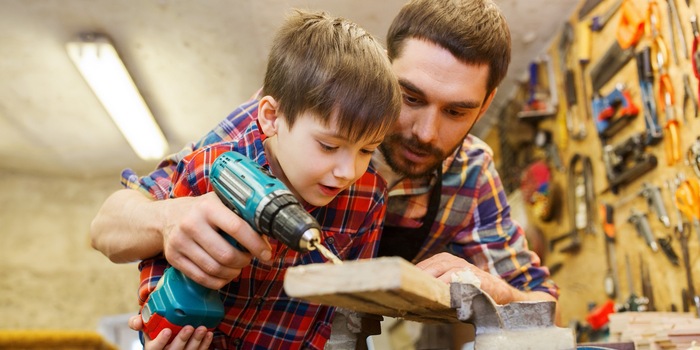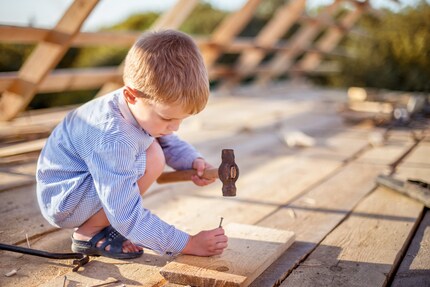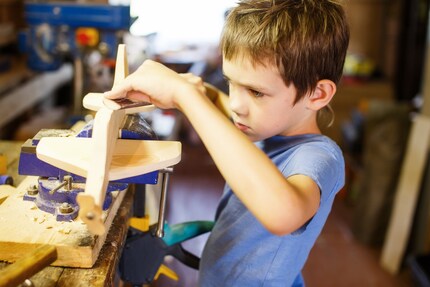
Tinker with your children to your heart's content
Children love to imitate adults. If you're a mum or dad and you thrive on DIY, your child will certainly soon want to do the same as you. And that's a good thing, because there are many advantages to doing DIY together. But there are a few things to bear in mind.
Do you love working with your hands and have big projects? Your favourite room is the workshop in the cellar and your shopping trips consist of going from one DIY shop to another? Your child has probably already noticed. And since children like to imitate the behaviour of adults, sooner or later they'll ask you if they can help. You don't really know if this is a good idea. You shouldn't throw in the towel before the project has even started, because for children it can be a great experience.
Work boosts self-confidence
Handwork encourages motor skills and concentration. Think back to your own craft lessons at school. For example, you had to follow a very precise line with the scroll saw, which required enormous concentration. Or hammering nails. If you didn't want to hit your own thumb, it was better to have well-developed fine motor skills.
Tinkering allows you to take on small challenges you've set yourself. These are good for the child's soul and boost self-confidence. After all, who doesn't feel a certain satisfaction when the nail finally disappears into the wood or when all the pieces fit together correctly? And when the project is finally finished and young children show off what they've created with their own hands, they find it hard to hide their pride.

Do-it-yourself activities also have a positive influence on creativity and imagination. Since the child doesn't have the final product in front of them, they have to try and imagine on their own what it will look like. It's not easy at first, but as time goes by and they learn more, they manage to do it quite well, using their imagination too. This gives the child an idea of the different tasks involved. By learning about various techniques and raw materials, your child will suddenly have many possibilities opening up to them.
Spending time together is great not only for the child, but for the whole family. While the hammers are banging and the wood chips are being sucked up, you become a close-knit team. Because as soon as tools come into play, you have to be able to trust each other. You have to trust your child to let them do things for themselves, and your child has to trust you, because you're looking out for them and giving them the right instructions.
.
You want to get started as soon as possible?
It's all in the preparation
Not so fast. Before you set to work, a certain amount of preparation is required. First of all, you need to make sure the work surface is big enough. If no workbench is available, a large table can also do the trick for a large number of tasks. The most important rules should also be discussed beforehand so that the children know what is expected of them. We all remember our parents' reminders. The classic: "Don't run with the scissors!" We laughed about it a lot with our friends, but these recommendations are really very important.
Once that's sorted, you need to come up with a project you want to do with your child. A birdhouse for the garden, a wooden train for the nursery or rather a frame for the latest family photo? It's important to keep a good overview and make sure the necessary tools and materials are available. There's nothing more annoying than having to interrupt the project at every turn to run to the DIY shop. Children and adults alike quickly lose motivation.
With no pretensions to perfection
We know very well: it's going to take ages and it's going to be anything but perfect. But it doesn't matter, because that should never be your intention. Or you'd be better off making it yourself. When you're doing something with children, really, it's not the end result that matters most, it's everything you have to do to get there. Achievement is beneficial for so many things (see above) that ultimately it doesn't matter whether an angle is 45° or 44°.
That's why you need to arm yourself with patience. This is the greatest of qualities. Have the patience to let the child work at their own pace and don't interfere with every little mistake. Show your child the steps, but also let him do them and give him compliments. And what does your child need? Motivation, of course! There's no point in tinkering if you don't want to. Instead of a passionate craftsman, you'll soon have a traumatised child at home. That's what happens with me and jogging. Even today I try to experience a little joy in running.

On the way to the woods
If you feel ready, then you can get started. But with what exactly? In my opinion, wooden projects are suitable for all ages. Wood is a relatively soft, natural material that's easy and versatile to work with. So beautiful results can be achieved with very little effort. And the smell is simply unbeatable!
Drilling, hammering and screwing are classic tasks that many children are already familiar with. That's why so many of them find it fun. However, a certain amount of dexterity is required. Sanding is particularly suitable for small children. It's a little easier and less dangerous, but the child can still see the progress they're making.
A final word of advice: whatever task you're currently working on, one thing is particularly important: the clamp. Children, especially little ones, don't have enough strength to hold their own equipment while they work. Once everything is tightly clamped, the child can concentrate on the actual task and the risk of injury is reduced.
So there's nothing standing in the way of the family project any more, and you can finally get down to DIY.
My life in a nutshell? On a quest to broaden my horizon. I love discovering and learning new skills and I see a chance to experience something new in everything – be it travelling, reading, cooking, movies or DIY.
From the latest iPhone to the return of 80s fashion. The editorial team will help you make sense of it all.
Show all